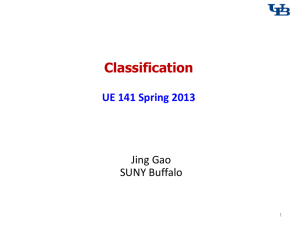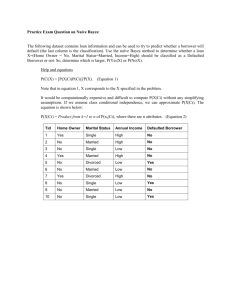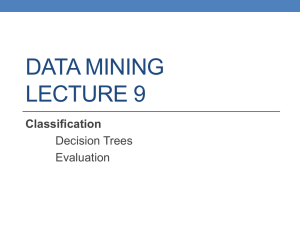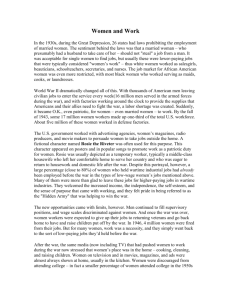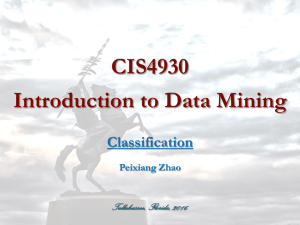Classification UE 141 Spring 2013 Jing Gao
advertisement
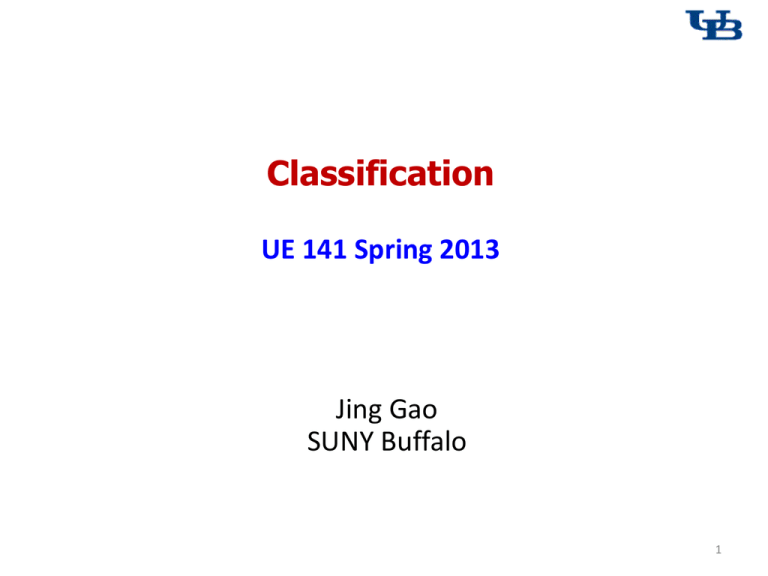
Classification UE 141 Spring 2013 Jing Gao SUNY Buffalo 1 Classification features patient class labels temp. blood pres. heart rate Sick? 99 110 90 Yes 100 120 100 Yes 96 130 65 No labeled training a model: f(x)=y: features class labels patient temp. blood pres. heart rate Sick? 98 130 80 115 110 95 test unlabeled 2 Illustrating Classification Task Tid Attrib1 1 Yes Large 125K No 2 No Medium 100K No 3 No Small 70K No 4 Yes Medium 120K No 5 No Large 95K Yes 6 No Medium 60K No 7 Yes Large 220K No 8 No Small 85K Yes 9 No Medium 75K No 10 No Small 90K Yes Attrib2 Attrib3 Class Learning algorithm Induction Learn Model Model 10 Training Set Tid Attrib1 Attrib2 Attrib3 11 No Small 55K ? 12 Yes Medium 80K ? 13 Yes Large 110K ? 14 No Small 95K ? 15 No Large 67K ? Apply Model Class Deduction 10 Test Set 3 Classification Techniques • • • • • • • Decision Tree Naïve Bayes Logistic Regression Support Vector Machines K nearest neighbor Ensemble learning …… 4 Example of a Decision Tree Tid Refund Marital Status Taxable Income Cheat 1 Yes Single 125K No 2 No Married 100K No 3 No Single 70K No 4 Yes Married 120K No 5 No Divorced 95K Yes 6 No Married No 7 Yes Divorced 220K No 8 No Single 85K Yes 9 No Married 75K No 10 No Single 90K Yes 60K Splitting Attributes Refund Yes No NO MarSt Single, Divorced TaxInc < 80K NO Married NO > 80K YES 10 Training Data Model: Decision Tree 5 Another Example of Decision Tree MarSt Tid Refund Marital Status Taxable Income Cheat 1 Yes Single 125K No 2 No Married 100K No 3 No Single 70K No 4 Yes Married 120K No 5 No Divorced 95K Yes 6 No Married No 7 Yes Divorced 220K No 8 No Single 85K Yes 9 No Married 75K No 10 No Single 90K Yes 60K Married NO Single, Divorced Refund No Yes NO TaxInc < 80K NO > 80K YES There could be more than one tree that fits the same data! 10 6 Apply Model to Test Data Test Data Start from the root of tree. Refund Yes Refund Marital Status Taxable Income Cheat No 80K Married ? 10 No NO MarSt Single, Divorced TaxInc < 80K NO Married NO > 80K YES 7 Apply Model to Test Data Test Data Refund Yes Refund Marital Status Taxable Income Cheat No 80K Married ? 10 No NO MarSt Single, Divorced TaxInc < 80K NO Married NO > 80K YES 8 Apply Model to Test Data Test Data Refund Yes Refund Marital Status Taxable Income Cheat No 80K Married ? 10 No NO MarSt Single, Divorced TaxInc < 80K NO Married NO > 80K YES 9 Apply Model to Test Data Test Data Refund Yes Refund Marital Status Taxable Income Cheat No 80K Married ? 10 No NO MarSt Single, Divorced TaxInc < 80K NO Married NO > 80K YES 10 Apply Model to Test Data Test Data Refund Yes Refund Marital Status Taxable Income Cheat No 80K Married ? 10 No NO MarSt Single, Divorced TaxInc < 80K NO Married NO > 80K YES 11 Apply Model to Test Data Test Data Refund Yes Refund Marital Status Taxable Income Cheat No 80K Married ? 10 No NO MarSt Single, Divorced TaxInc < 80K NO Married Assign Cheat to “No” NO > 80K YES 12 Build a Decision Tree • Let Dt be the set of training records that reach a node t Tid Refund Marital Status Taxable Income Cheat 1 Yes Single 125K No • General Procedure: 2 No Married 100K No 3 No Single 70K No 4 Yes Married 120K No 5 No Divorced 95K Yes 6 No Married No 7 Yes Divorced 220K No 8 No Single 85K Yes 9 No Married 75K No 10 No Single 90K Yes – If Dt contains records that belong the same class yt, then t is a leaf node labeled as yt – If Dt contains records that belong to more than one class, use an attribute to split the data into smaller subsets. Recursively apply the procedure to each subset 60K 10 Dt ? 13 Example Refund Yes No Don’t Cheat Refund Refund Yes No Don’t Marital Cheat Status Single, Married Divorced Don’t Cheat Yes No Tid Refund Marital Status Taxable Income Cheat 1 Yes Single 125K No 2 No Married 100K No 3 No Single 70K No 4 Yes Married 120K No 5 No Divorced 95K Yes 6 No Married No 7 Yes Divorced 220K No 8 No Single 85K Yes 9 No Married 75K No No Single 90K Yes Don’t Marital 10 Cheat Status Single, Married Divorced Don’t Taxable Cheat Income 60K 10 < 80K Don’t Cheat >= 80K Cheat 14 How to determine the Best Split Before Splitting: 10 records of class 0, 10 records of class 1 OnCampus? Yes No Car Type? Family Student ID? Luxury c1 c10 Sports C0: 6 C1: 4 C0: 4 C1: 6 C0: 1 C1: 3 C0: 8 C1: 0 c20 C0: 1 C1: 7 C0: 1 C1: 0 ... C0: 1 C1: 0 c11 C0: 0 C1: 1 ... C0: 0 C1: 1 Which test condition is the best? 15 Question • The basic idea of classification approach is to learn from the past to predict the future. – Are there some cases that are unpredictable or very difficult to predict? – If we apply classification algorithms to such cases, what results we will get? 16
